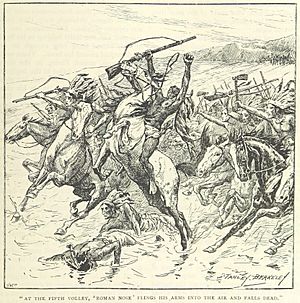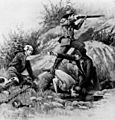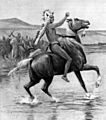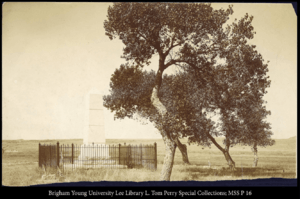Battle of Beecher Island facts for kids
Quick facts for kids Battle of Beecher Island |
|||||||
|---|---|---|---|---|---|---|---|
| Part of the Comanche War, American Indian Wars | |||||||
 A map of the Republican River and its tributaries, with the location of Beecher Island highlighted in red. |
|||||||
|
|||||||
| Belligerents | |||||||
| Arapaho Cheyenne Sioux |
|||||||
| Commanders and leaders | |||||||
| Roman Nose† | |||||||
| Strength | |||||||
| 50 cavalry | 200-1,000 warriors | ||||||
| Casualties and losses | |||||||
| 6 killed 15 wounded |
9–32 killed | ||||||
The Battle of Beecher Island, also known as the Battle of Arikaree Fork, was a fight between the United States Army and several Native American tribes in September 1868. It took place on an island in the Arikaree River, near what is now Wray, Colorado. The island was later named Beecher Island to honor Lieutenant Fredrick H. Beecher, an army officer who died during the battle.
Contents
Why the Battle Happened
In 1868, Cheyenne and Arapaho tribes often raided areas in Kansas. These raids were part of their traditional hunting activities. They were also a response to past conflicts with the military, like the Sand Creek massacre. White settlers were moving west, building towns and railroads across Kansas. This led to more tension and fighting.
Some Cheyenne leaders wanted peace, moving south out of Kansas. But younger warriors continued to fight. In August 1868, General Philip Sheridan took command of the military in the area. He was asked for help after many settlers were killed in attacks. Sheridan decided to try a new plan to deal with the raids.
Forming a Special Scout Team
General Sheridan needed a new way to fight the small, spread-out groups of Native American warriors. He asked Major George Alexander Forsyth, a veteran of the American Civil War, to create a special team. This team would be made of "fifty first-class hardy frontiersmen." Their job was to find and fight the Native American warriors using their own tactics.
Forsyth chose 48 men from Forts Harker and Fort Hays. They were armed with powerful Spencer repeating rifles. Lieutenant Fredrick H. Beecher, a brave soldier, was Forsyth's second-in-command. The scouts rode for many days, looking for signs of Native Americans.
The Battle Begins
On September 10, 1868, Forsyth's scouts learned that Native Americans had attacked a supply train near Fort Wallace. Colonel Forsyth and his men quickly went to investigate. They followed a trail that showed a large group of Native Americans had been involved. Even though they were greatly outnumbered, the scouts kept going.
On the evening of September 16, Forsyth and his men camped by the "Dry Fork of the Republican River," now called the Arikaree River. They didn't know they were only 12 miles downstream from a large Native American camp. This camp included Lakota Sioux, Cheyenne Dog Soldiers led by Roman Nose, and some Arapaho.
A Surprise Attack Thwarted
On the morning of September 17, hundreds of Native American warriors surrounded Forsyth's camp. Estimates of their numbers ranged from 200 to 1,000. A small group tried to scare the soldiers' horses away. Forsyth heard their war cries and quickly got his men ready.
Dozens of warriors charged towards Forsyth's position. But the scouts quickly moved to a sandbar in the river. They tied their horses to bushes to create a barrier. The scouts used their fast-firing Spencer rifles to defend themselves. The Native American warriors were surprised by the scouts' strong defense and changed their plans.
The warriors tried to attack the sandbar many times. They crawled through the grass and shot from hidden spots. The scouts killed their horses to use as protection and dug pits in the sand. Several scouts were killed or wounded by hidden snipers. The Native Americans surrounded the island and kept attacking.
Roman Nose's Last Stand
Roman Nose, a respected Cheyenne warrior, at first did not join the battle. He believed he would die if he fought that day because he had broken a sacred rule. But after another warrior called him a coward, he decided to lead the next attack.
When Forsyth saw the charge coming, he told his men to wait until the warriors were very close. After several rounds of firing, Roman Nose was shot in the back. He fell near the riverbank. Other warriors quickly pulled him away. Roman Nose died later that night.
Many other warriors were killed or wounded. Four scouts, including Lieutenant Beecher, were killed. Fifteen more scouts were wounded, including Colonel Forsyth. Forsyth was shot three times. One bullet grazed his head, another shattered his leg, and a third was dangerously close to a major artery.
A Call for Help
Before dawn on the second day, Forsyth knew they needed help. He asked for volunteers to go to Fort Wallace, which was about 70 miles away. Simpson "Jack" Stilwell bravely stepped forward. He chose Pierre Trudeau to go with him.
Stilwell and Trudeau crawled for three miles on the first day to avoid being seen. They had to hide from Native Americans for four days during their journey. They had only horse meat to eat, and it made them sick. Trudeau became very weak. But after resting, they finally reached Fort Wallace.
Two nights after Stilwell and Trudeau left, two more scouts, John J. Donovan and Allison J. Pliley, also left the island to get help. The men on the island didn't know if any of the scouts had made it through. On the fourth day of the battle, Forsyth used his own razor to remove a bullet from his leg when his men refused. Everyone wondered if help would arrive in time.
-
The Rescue
A soldier offers aid to his wounded comrade after the Battle of Beecher Island. The Harper's article states that this is Bvt. Col. Louis H. Carpenter greeting Lt. Col. G. A. Forsyth who was twice wounded. Notice officer shoulder boards.
The Rescue Arrives
Three rescue teams set out from Fort Wallace, taking different paths. Lieutenant Colonel Louis H. Carpenter led two troops of the 10th Cavalry Regiment, known as Buffalo Soldiers. Major Brisbin led two troops of the 2nd Cavalry. Captain Bankhead led about 100 men of the 5th Infantry.
Around dawn on September 25, Lieutenant Colonel Carpenter's troops met Scout John Donovan. Donovan had reached Fort Wallace and was already heading back to the battlefield with four new riders. Carpenter's men were the first to reach Forsyth's unit. Carpenter later received the Medal of Honor for his bravery.
When the rescuers arrived, they found over fifty dead horses around the island. The smell was terrible. Forsyth's men had run out of food and were forced to eat the decaying horse meat. The air was filled with flies. Forsyth was lying in a sandy pit, surrounded by the dead horses that had protected them.
Carpenter immediately secured the area. He set up tents away from the smell. The wounded men were carefully moved to the tents for fresh air. The dead men were buried to prevent disease. The next day, another scout died from his wounds and was buried. Sixteen others were wounded. On September 27, the Forsyth Scouts left for Fort Wallace, escorted by the 10th Cavalry.
What Happened After the Battle?
The "Forsyth Scouts" arrived back at Fort Wallace on September 30. General George Custer later called the fight at Arikaree "the greatest battle on the plains." To the Cheyenne, it was remembered as "The Fight when Roman Nose was Killed."
Only nine Native Americans were confirmed killed, but U.S. soldiers claimed many more. Years later, Forsyth met a Lakota warrior who had been at the battle. The warrior said that 75 Native Americans had died and many more were wounded. The battle's importance as a way to fight Native American tribes was not fully recognized at the time.
The battle site was added to the National Register of Historic Places in 1976. The next spring, Captain Brown returned to find the bodies of the scouts. He found two, but three graves were empty, likely moved by Native Americans. A monument was later built by the states of Colorado and Kansas at the battle site.
Important Historical Sites
- National Register of Historic Places #NPS–76000569 — "Beecher Island Battleground Memorial" site







